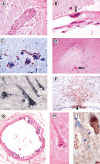Henipavirus Encephalitis: Recent Developments and Advances
- PMID: 26276024
- PMCID: PMC7161744
- DOI: 10.1111/bpa.12278
Henipavirus Encephalitis: Recent Developments and Advances
Abstract
The genus Henipavirus within the family Paramyxoviridae includes the Hendra virus (HeV) and Nipah virus (NiV) which were discovered in the 1990s in Australia and Malaysia, respectively, after emerging to cause severe and often fatal outbreaks in humans and animals. While HeV is confined to Australia, more recent NiV outbreaks have been reported in Bangladesh, India and the Philippines. The clinical manifestations of both henipaviruses in humans appear similar, with a predominance of an acute encephalitic syndrome. Likewise, the pathological features are similar and characterized by disseminated, multi-organ vasculopathy comprising endothelial infection/ulceration, vasculitis, vasculitis-induced thrombosis/occlusion, parenchymal ischemia/microinfarction, and parenchymal cell infection in the central nervous system (CNS), lung, kidney and other major organs. This unique dual pathogenetic mechanism of vasculitis-induced microinfarction and neuronal infection causes severe tissue damage in the CNS. Both viruses can also cause relapsing encephalitis months and years after the acute infection. Many animal models studied to date have largely confirmed the pathology of henipavirus infection, and provided the means to test new therapeutic agents and vaccines. As the bat is the natural host of henipaviruses and has worldwide distribution, spillover events into human populations are expected to occur in the future.
Keywords: Hendra virus; Nipah virus; encephalitis; pathological.
© 2015 International Society of Neuropathology.
Figures


References
-
- Abdullah S, Chang LY, Rahmat K, Goh KJ, Tan CT (2012) Late‐onset Nipah virus encephalitis 11 years after the initial outbreak: a case report. Neurol Asia 17:71–74.
Publication types
MeSH terms
Substances
LinkOut - more resources
Full Text Sources
Other Literature Sources
Research Materials

